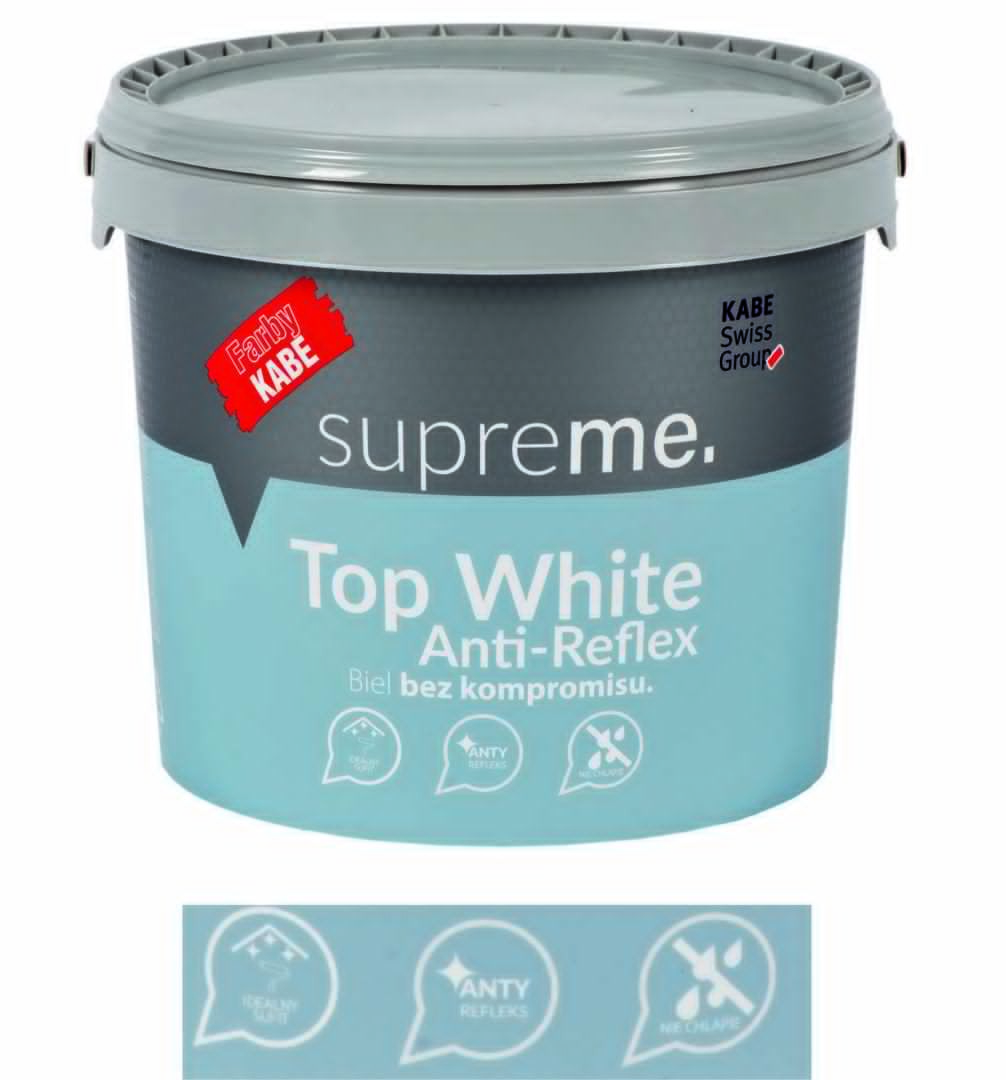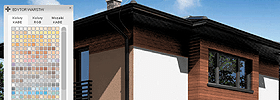TOP WHITE Anti-Reflex

Paint for walls and ceilings
A modern dispersion topcoat paint for performance aesthetic super white paint coatings inside buildings. It is intended for painting walls and ceilings in “dry” rooms (such as: living room, bedroom, hall, offices and conference rooms). The paint reduces light reflections that create the impression of uneven substrate. It can be used for decorative and protective painting of surfaces inside residential, office and public buildings, including school and educational facilities (schools, kindergartens) and health care facilities (hospitals), production plants, including the food industry (without direct contact with food). It makes up aesthetic, smooth coating of high finishing standard and pleasant matt optics. It features high resistance to yellowing and washing off or scrubbing.
It is applied for primary and renovation painting of mineral substrates (such as: concrete, cement, cement-lime, lime and gypsum plasters, as well as gypsum boards), and on substrates covered with well set and bound polymer-based coats.
Absorbent or chalking substrates must be primed with AQUALIT primer prior to paint application.
| Base binder: | copolymer binder; |
| Pigments: | titanium dioxide white powder; |
| The content of volatile organic compounds VOC: | cat. A/a. The product contains less than 30 g/l VOC; |
| Density: | ca. 1.50 g/cm³; |
| Colour: | super white; |
| Gloss level: | deep matt; |
| Diluent: | water; |
| Average coverage: | ca. 0.25 l/m² (with double painting on a smooth substrate); |
| Temperature of application (air and substrate): | from +5°C to +25°C; |
| Relative humidity: | ≤80%; |
| Resistance to wet scrubbing: | paint of class II (per PN-EN 13300 standard) and class I (per PN-C-81914:2002); |
| Packaging: | Single-use plastic packaging of 2.5 and 10 l; |
| Storage: | The product should be stored in its sealed packaging in a cool, but frost-protected room. Keep out of the reach of children; |
| Shelf life: | 18 months from the production date specified on the packaging of the product with originally closed packaging. |
• Deep matt
• Super white
• Very good coverage
• Anti-reflection
• Non-dripping texture
• Perfect effect
• On mineral and painted substrates
SUBSTRATE PREPARATION: Apply to a sound/stable and clean substrate (without cracks and delaminations), degreased, dry, and free of biological contamination or chemical efflorescence. In the case of fungal growth, the substrate should be mechanically cleaned and then disinfect with an indoor fungicide. Discolourations, nicotine stains and efflorescences caused by water stains should be painted first with MILAMAT stain blocker. Any loose layers not bound to the substrate (i.e. loose render or flaked coatings) should be removed. The remnants of adhesive or lime paints should be thoroughly removed and the substrate washed with water. Old and/or dirty substrates should be washed off and degreased with water and CLEANFORCE cleaning agent. For uneven substrates, first use KOMBI FINISZ levelling compound and then level the surface with PROFINISZ ready-to-use finishing compound. Small unevenness can be levelled out at once with PROFINISZ ready-to-use finishing compound. Absorbent substrates should be primed with BUDOGRUNT WG before levelling compounds application. Fresh cement plasters and cement-lime plasters may be painted after 3-4 weeks of curing period, gypsum plasters after 2 weeks, while the so-called drywall construction can be painted directly after polishing and dust removing.
PRIMING: Absorbent or dusty (strongly chalking) substrate should be primed with AQUALIT before applying the paint. Typical drying time ca. 3 h for the product or base applied on the substrate in optimum conditions (20°C, 55% RH).
When primer or base applied on the substrate is completely dry, TOP WHITE ANTI-REFLEX paint may be applied. Note: Substrates of low wettability (such as top coats based on polymers or dispersion paint coatings) should not be primed and only washed with water with the addition of CLEANFORCE cleaning agent.
PAINT PREPARATION: If required, add a small amount of clean water adding 10% of volume for the first painting and 5% for the second one (when determining the amount of water, it is necessary to take into account the type of substrate, drying conditions and application technique).
APPLICATION: Paint should be applied on the substrate in two layers with a brush, roller or by spraying (including also the ‘airless’ method). It is recommended to use a roller made of fleece with a bristle length of 18 mm. The second coat can be applied only after the first one is completely dry.
DRYING: Typical drying time of a single layer of paint applied to the substrate lasts approx. 3 h (20°C, 55% RH) After painting, closed rooms to be ventilated until the specific smell disappears. Note: Drying time may be longer due to low temperatures and high relative humidity. The coating obtains its full mechanical and functional properties after 4 weeks.
USEFUL HINTS: To avoid colour differences, a single batch product should be applied to entire facade or element in one working cycle. Application and drying of the paint requires air temperature above +5°C. All tools to be cleaned with water after finishing work.
ADDITIONAL OPTIONS: When applying the paint on substrates with scratches up to 0.3 mm wide (such as shrinkage cracks in mineral plaster), it is recommended to use a microfiber-reinforced paint for the first painting (option available order). In order to increase the resistance of the paint coating to mould growth, it is recommended to apply a special protective agent to the paint (additional service).


 TOP WHITE Anti-Reflex - TDS
TOP WHITE Anti-Reflex - TDS